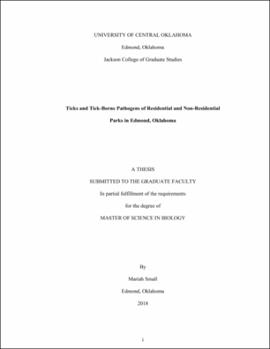| dc.contributor.advisor | Brennan, Robert | |
| dc.contributor.author | Small, Mariah | |
| dc.date.accessioned | 2020-07-09T14:40:59Z | |
| dc.date.available | 2020-07-09T14:40:59Z | |
| dc.date.issued | 2018 | |
| dc.identifier.other | (AlmaMMSId)9982679066602196 | |
| dc.identifier.uri | https://hdl.handle.net/11244/325099 | |
| dc.description.abstract | The Oklahoma State Department of Health (OSDH) provides annual summaries of infectious diseases that occur in individuals treated in a medical facility. The summaries include five bacterial tick-borne diseases. Over the last 30 years, the number of people infected with ehrlichiosis and Rocky Mountain spotted fever has increased in Oklahoma. Few studies across the United States have sampled ticks in all months of the year and there is limited data on tick seasonality. There also is a lack of data on pathogen prevalence within urban environments. To assess the prevalence of these tick-borne pathogens in different environments across seasons, ticks were collected from two parks, one residential and one non-residential, in Edmond, Oklahoma, for one continuous year. The presence of tick-borne pathogens was determined using quantitative real-time polymerase chain reaction (qPCR). Over the year, 2,450 ticks were collected with four different species represented. Prior to this study only one of the four species collected was considered to have established populations in Oklahoma County. This study provided novel data of established populations for Amblyomma maculatum (Gulf Coast), Dermacentor variabilis (American dog), and Ixodes scapularis (deer). Of the ticks collected, more than 90% were Amblyomma americanum (lone star); therefore, this species was the focus for determining pathogen prevalence. Rickettsia rickettsii was not detected in the ticks tested. From the residential park, 289 ticks were tested and 14% were positive for Ehrlichia chaffeensis and 27% for Rickettsia amblyommii. In contrast, E. chaffeensis was detected in 20% and R. amblyommii in 29% of 145 A. americanum from the non-residential park. This data can be used by the City of Edmond Parks and Recreation department to inform park visitors and caretakers of the potential risk of encountering ticks and tick-borne pathogens. Future studies are needed to determine pathogen prevalence among other tick species, additional pathogens, and host studies because the scope of my study was focused on one tick species and three bacterial pathogens. This study and future studies will provide increased understanding of the potential risk for encountering tick-borne pathogens, in addition to changing host populations, in urban environments. | |
| dc.rights | All rights reserved by the author, who has granted UCO Chambers Library the non-exclusive right to share this material in its online repositories. Contact UCO Chambers Library's Digital Initiatives Working Group at diwg@uco.edu for the permission policy on the use, reproduction or distribution of this material. | |
| dc.subject.lcsh | Ticks as carriers of disease | |
| dc.subject.lcsh | Tick-borne diseases | |
| dc.subject.lcsh | Parks | |
| dc.title | Ticks and tick-borne pathogens of residential and non-residential parks in Edmond, Oklahoma. | |
| dc.type | Academic theses | |
| dc.contributor.committeeMember | Haynie, Michelle L., 1975- | |
| dc.contributor.committeeMember | King, Chad | |
| dc.contributor.committeeMember | Laverty, Sean | |
| dc.thesis.degree | M.S., Biology | |
| dc.subject.keywords | Amblyomma americanum | |
| dc.subject.keywords | Oklahoma | |
| dc.subject.keywords | Park | |
| dc.subject.keywords | Residential | |
| dc.subject.keywords | Rickettsia | |
| dc.subject.keywords | Tick | |
| dc.identifier.oclc | (OCoLC)1127910933 | |
| uco.group | UCO - Graduate Works and Theses::UCO - Theses | |
| thesis.degree.grantor | Jackson College of Graduate Studies. | |
